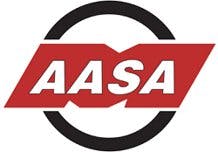Interested in more technology news? Sign up for our new Aftermarket IT newsletter by clicking here!
When Woodland was a graduate student and teacher at Drexel Institute of Technology, he was frustrated because the school did not want to engage in the development of technology to capture product information at grocery store checkouts. He left school in 1948 to pursue the concept and moved to Florida. While at the beach one day, he began drawing in the sand what would become the most widely used technology in history to identify and track items from production to consumer – the Bar Code.
Woodland’s inspiration came from his knowledge of the Morse Code he learned as a Boy Scout. Dots and dashes in the sand became 2-D visual representations of product information with the varying widths of lines containing and conveying specific data. He worked for IBM for many years developing and commercializing bar code technology and eventually moved to North Carolina with IBM to help develop the Universal Product Code (UPC). The next major development in product identification and tracking was RFID, and there have been a couple of decades of minor and major innovations associated with this technology. RFID’s cost is dropping, and its acceptance and use is growing.
Nice piece of history, but why should the automotive aftermarket pay attention? Technology developments that impact business and supply chain processes originate either in slow methodical iterations or in major innovations that cause market disruptions. Our industry needs advancements from both approaches. Both approaches require thinking. Thinking takes time. This mandates that aftermarket technology leaders are intentional about allocating time away from meeting customer (external and internal) needs to research non-related technologies that could help resolve aftermarket challenges, brainstorm with peers and think about what could be.
An example would be to consider how a creative use of RFID I read about recently might be used in the aftermarket. Some boutique coffee shops provide customers branded mugs with RFID chips. Customers enjoy the convenience and time savings of walking into a store and simply holding the mug under a dispenser, which pours the customer’s favorite “legal drug” based on data from the company’s database and information gleaned from the chip. The customer’s account is charged for the appropriate amount and he or she can leave immediately without standing in line. Think about potential implications of this technology to improving customer satisfaction at any level of the aftermarket channel.
Another interesting exercise is to consider if the aftermarket will adopt RFID across the supply chain, or will it leapfrog to the next technology that is probably already being developed somewhere. This would be analogous to certain Asian regions that essentially leapfrogged landline phone systems to mobile/cell technology over a very short period of time.
What is next? I’m not just asking about the next product identification and tracking technology. What is the next true innovation for any process, system, interaction, transaction, data transfer and communication that will occur in the aftermarket? Whether one prefers sketches on cocktail napkins or fingers in the sand, our industry needs leaders to visualize and conceptualize technology innovations that are derived from open minds and thinking.
The AASA Technology Council (ATC) has established forums to foster open dialog and collaborative thinking on advanced technologies. The next opportunity for this will be the ATC Spring Meeting, which will take place on Friday, March 15 in Rosemont, Ill. Visit www.aasatechnology.org for more information.
Subscribe to Aftermarket Business World and receive articles like this every month….absolutely free. Click here.


